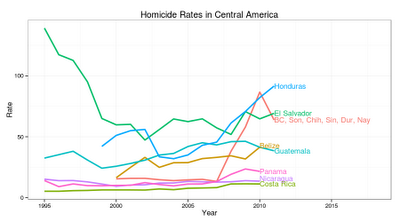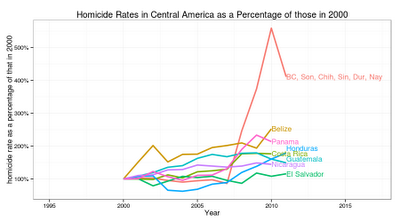 |
| Rates for Panama and Nicaragua are from 2009, all other countries 2010. Municipalities which are part of a metro area in Mexico are shown with the metro area homicide rate. |
Having just posted on violence along Mexico’s northern border, I figured it’s time to analyze what is happing south of Mexico where some countries have experienced sharp increases in homicides.
It’s a little bit fallacious to compare a country as big as Mexico with its southern neighbors since Mexico’s most populous state has more people living in it than the entire country of Guatemala, and all Mexican states are more populous than Belize, also the administrative divisions in each country are a little bit different:
In Mexico the divisions go something like this:
States -> Municipalities (Counties)
In Guatemala:
Deparments -> Municipalities
In Belize:
Districts -> Constituencies
So in the map I’m showing at the top of this post I’m comparing level 1 divisions in Guatemala and Belize (departments and districts) with level 2 divisions in Mexico (municipalities).
In addition, homicide records are not always reliable in both Mexico and Guatemala, in Mexico vital statistics records of homicides based on death certificates are usually more reliable than those compiled from police records, but in Chiapas –which borders Guatemala– police records consistently record a higher number of homicides. Looking at the monthly data one can see that some months both transportation accidents and homicides fall to levels near zero. I interpret this as Chiapas not being able to register every death, being one of Mexico’s poorest states this is not surprising. Chiapas health records are not up to par with the rest of the country.
Homicides in Chiapas from different sources:
| 2010 | 2011 | |
| INEGI(Vital Statistics) | 197 | 185 |
| SNSP(Police) | 513 | 613 |
In Guatemala police records consistently document more homicides than vital statistics compiled by health authorities, though there are a lot of deaths of unknown intent. I interpret this as police records being more accurate than vital statistics.
With all that said it’s now a matter of collecting the data. Lucky for me, La Prensa Gráfica compiled homicide statistics for Central America and they used the police sources for Guatemala. So, it’s mostly a matter of downloading and merging shapefiles to analyze the data:
getMaps <- function(codes, level) { ##Different column names to uniquely identify each group ##depending on the level requested column.name <- ifelse(level == 1, "NAME_0", "ISO") ##Download the maps country.ll <- llply(codes, function(x) getData("GADM", path = "maps", country = x, level = level)) ##Change the id of the maps since some are repeated and we need to ##merge them, use ISO code as the unique identifier country.ll <- llply(country.ll, function(x) spChFIDs(x, str_c(row.names(x), x[[column.name]][1]))) ##Merge the list of maps one by one for(i in 2:length(country.ll)){ if(i == 2) { map <- spRbind(country.ll[[1]], country.ll[[2]]) } else { map <- spRbind(map, country.ll[[i]]) } } map } ##Codes for the Central American Countries country.codes <- c("GTM", "BLZ", "HND", "SLV", "CRI", "NIC", "PAN") ##Get the maps of States/Districts map <- getMaps(country.codes, level = 1) ##Get the maps of the country outlines map.borders <- getMaps(country.codes, level = 0)
Here’s a map showing the homicide rates from police sources in the Mexican states that border Guatemala and Belize:
 |
| Rates for Panama and Nicaragua are from 2009, Mexico from 2011, and all other countries 2010. Data for Central America from La Prensa Gráfica, Mexico from SNSP |
If the police homicide statistics are closer to reality, then the border states of Mexico would have a homicide rate of 13 (about the same level as metro Mexico City). The departments and districts of Guatemala and Belize that touch the border with Mexico would have a combined homicide rate of 20 (about the same level as metro Detroit or New Orleans). And as you can see, the most violent part of Guatemala is closer to Honduras and El Salvador than Mexico, with the big exception of Petén. I wonder why the souther border hasn’t seen the increase in violence seen in other parts of Mexico? The real contrast is provided by Nicaragua.
The intensity of drug trafficking does seem to be correlated with homicides according to this report by the World Bank (page 13).
For the time series of homicide rates I added a line representing the Mexican states of Baja California, Sonora, Chihuahua, Sinaloa, Durango and Nayarit to serve as comparison, together these states would have a population similar to that of Guatemala and about twice that of El Salvador or Honduras, though their area is much bigger and their GDP per capita much higher. Belize is a pretty small country, so keep in mind that while the trend is increasing, the number of homicides went from 41 in 2000 to 129 in 2010. Another thing to keep in mind is that Central American countries are very young and Ceteris Paribus having more young adults will mean more homicides.
 |
| Sources: UNODC Homicide Statistics 2012, INEGI |
 |
| Sources: UNODC Homicide Statistics 2012, INEGI |
Here’s an interactive map:
(Municipalities which are part of a metro area in Mexico are shown with the metro area homicide rate.)
P.S. Data and code are available from GitHub
